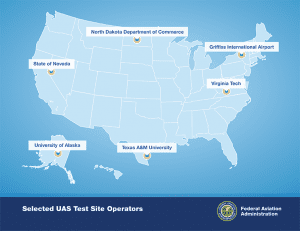
In selecting the six test site operators, FAA considered geography, climate, location of ground infrastructure, research needs, airspace use, safety, aviation experience and risk. The six test applications achieve cross-country geographic and climatic diversity and help FAA meet its UAS research needs.
After a rigorous 10-month selection process involving 25 proposals from 24 states, the Federal Aviation Administration (FAA) selected six unmanned aircraft system (UAS) research and test site operators across the country. The following paragraphs provide a brief description of the operators and the research they will conduct into future UAS use:
University of Alaska. The University of Alaska proposal contained a diverse set of test site range locations in seven climatic zones as well as geographic diversity with test site range locations in Hawaii and Oregon. The research plan includes the development of a set of standards for unmanned aircraft categories, state monitoring and navigation. Alaska also plans to work on safety standards for UAS operations.
State of Nevada. Nevada's project objectives concentrate on UAS standards and operations as well as operator standards and certification requirements. The applicant's research also will include a concentrated look at how air traffic control procedures will evolve with the introduction of UASs into the civil environment. Nevada's selection contributes to geographic and climatic diversity.
New York's Griffiss International Airport. Griffiss International plans to work on developing test and evaluation as well as verification and validation processes under FAA safety oversight. The applicant also plans to focus its research on sense and avoid capabilities, and its sites will aid in researching the complexities of integrating UASs into the congested northeast airspace.
North Dakota Department of Commerce. North Dakota plans to develop UAS airworthiness data and validate high-reliability link technology. In addition, the applicant will conduct human factors research. North Dakota's application was the only one to offer a test range in the temperate (continental) climate zone and included a variety of different airspaces that will benefit multiple users.
Texas A&M University”Corpus Christi. Texas A&M plans to develop system safety requirements for UAS vehicles and operations with a goal of protocols and procedures for airworthiness testing. The selection of Texas A&M contributes to geographic and climactic diversity.
Virginia Polytechnic Institute and State University (Virginia Tech). Virginia Tech plans to conduct UAS failure mode testing and identify and evaluate operational and technical risks areas. The proposal includes test site range locations in Virginia and New Jersey.
Image courtesy of FAA.

